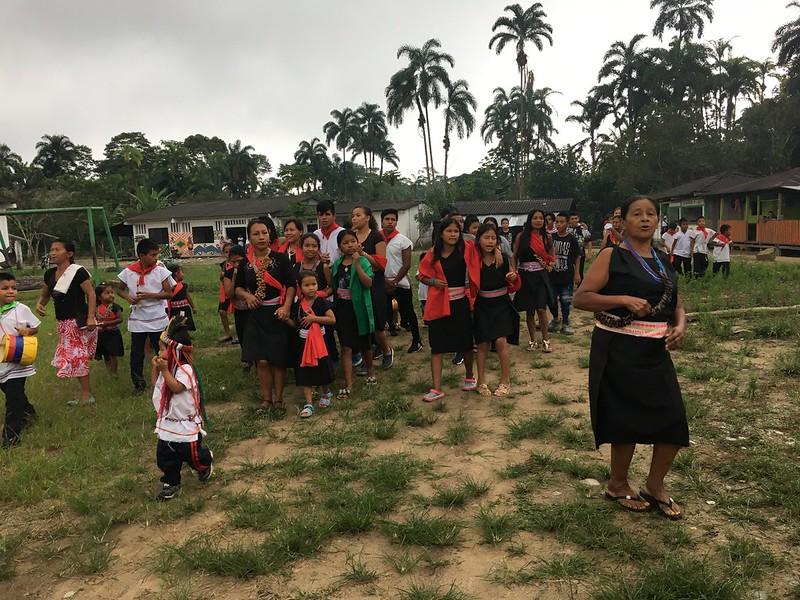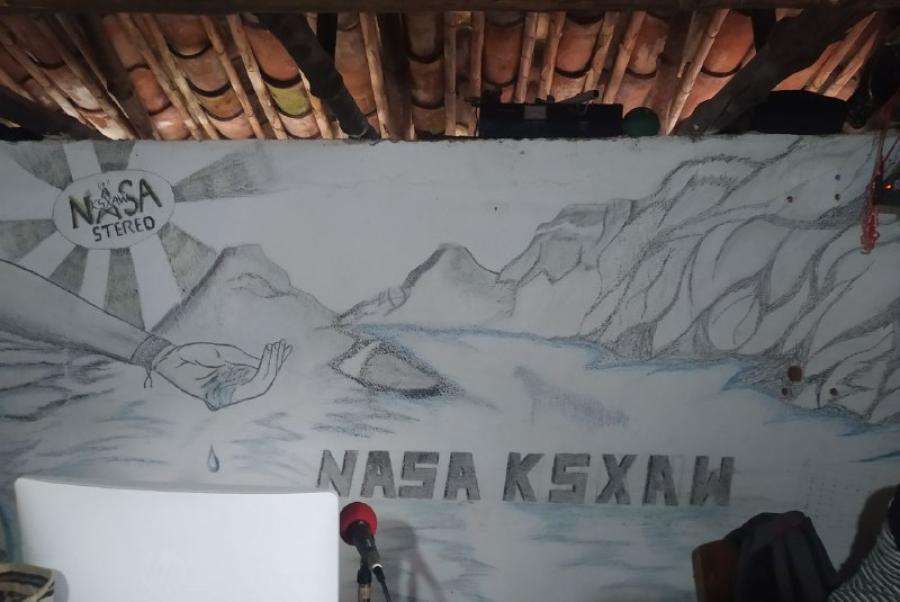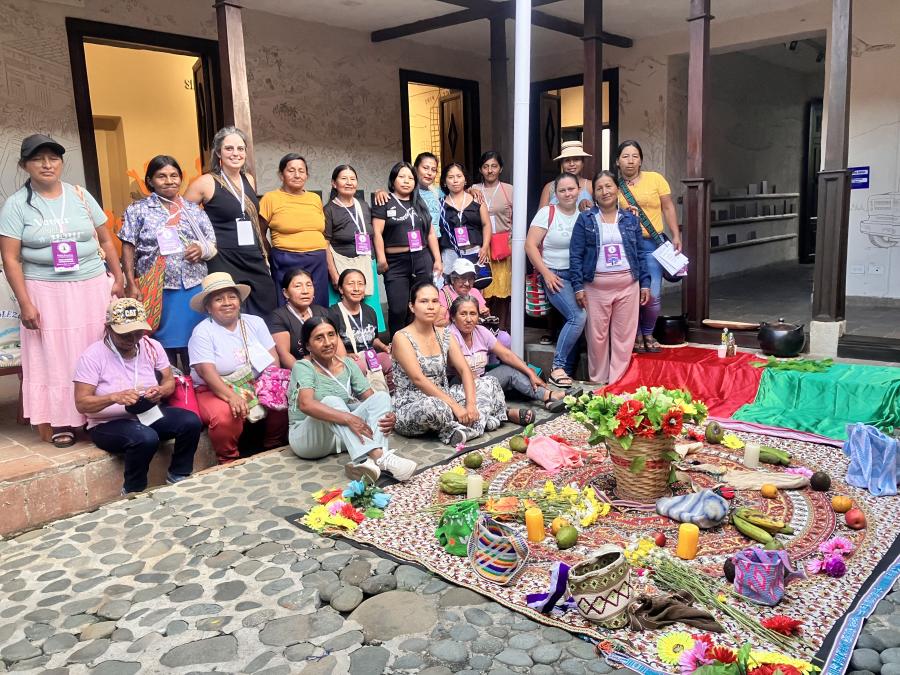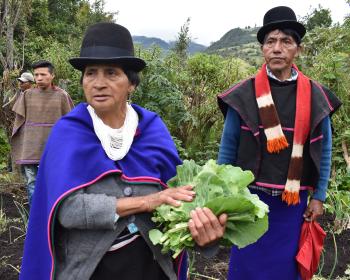
Resguardo Indígena Inga San Miguel de la Castellana aims to strengthen the Inga language among youth in the Villagarzón municipality of Colombia. They have seen much success since benefitting from a grant from Cultural Survival’s Keepers of the Earth Fund. Ex-governor Isais Buesaquillo states, “The risk of the survival of the culture runs risks, the reduction of territorial spaces leads to the weakening of our culture.” Teacher Rosalba Jacanamejoy has witnessed this firsthand: in the seventies, everyone communicated in Inga. Now, most Inga speak Spanish amongst themselves.
The revitalization of the Inga language and culture is critical, as it guarantees that individuals will continue to identify as part of the community and pass on their knowledge to future generations. Moreover, language use strengthens all aspects of Inga culture and autonomy. “Our language is beautiful,” Edna Viviana Papamija said, “It is the expression of who we are, how we live.”

In order to promote Inga language and culture, four main initiatives were undertaken by the Resguardo: Indigenous flora and fauna education, and the use of these in Indigenous cooking; the celebration and commemoration of Atun Puncha Day; traditional games, songs, and education about the Inga bodoquera; and the practice of Indigenous medicine. Not only did the organization gain participation from the youth it hoped to target, but it did so with support from elders, artisans, ex-governors, the current governor Aida Acanamejoy, and other members from the wider Inga community.
The project began by establishing shared authority between the youth and linguistics professionals to ensure the largest impact. A general assembly was held to teach the community about the project. After a system of shared decision-making and collective effort was established, four key initiatives were put into motion. The first aimed to help Inga youth discover the flora and fauna of their ancestral lands, followed by education about how to utilize these natural resources to cook traditional Inga food. Youth visited the countryside with elders, who explained to them in Inga the properties and characteristics of natural life—trees, plants, animals, and so on—around them, relating each species to the preparation of Indigenous food.

The food preparation methods taught to the youth involved traditional Inga techniques such as smoking and grilling. Youth learned how to make maitukusaska, which is prepared by wrapping fish with natural seasonings in sirindango leaf, and then roasted on a charcoal grill. Another local food indispensable in Indigenous families is uchu, a spicy fruit that accompanies several traditional foods. The whole community was enthusiastic about this combined educational and culinary project, and was excited about respecting cultural values and listening to elders speak in the Inga language. Elders taught the youth about the importance of eating natural whole foods in order to remain healthy. This way of life, they cautioned, is increasingly threatened by external actors, making the protection of ancestral lands even more important.
The second initiative was a celebration and special commemoration for Atun Puncha, a big day for the Inga community. Everyone wore crowns of feathers, traditional clothing, and necklaces of beads and natural seeds, and thanked each other and the Earth for everything they have been provided. Together, the whole community ate traditional meals, danced and sang together, and commemorated loved ones who have passed away. The presence of the Inga language was strong, and especially because the day is a moment of cultural strength, resistance, and perseverance; one of the most popular phrases of the day is “kausankamalla,” which means “as long as you live.”

Next, the Resguardo led a project to help the community learn traditional games and songs. One elder, Enrique Jojoa, told the story of the bodoquera, a kind of blowgun used to defend Inga territory against invaders: his father preserved the legacy of the device, which is now about 150 years old, with all of its materials, hardness, and color intact. To make it one needs to be aware of the phases of the moon for cutting materials like sticks and wood, to know how to measure materials and apply geometry, and to use the Inga worldview; as a result, one will be able to have an abundance of play, hunting, and self-defense. The historical significance of the bodoquera lives on and is strengthened by elders like Jojoa who continue to pass traditional culture down to the youth of the community, and to do so in the Inga language. Inspired, the youth are now excited to make many more bodoqueras.
The fourth initiative worked within the theme of traditional medicine. Taita Sinchi, a traditional Indigenous doctor recognized for his work in ancestral medicine, helped participants prepare, under the protection of the territory’s ancestral spirits, to take yagé, or ayahuasca. A psychoactive tea that is known to induce deeply spiritual experiences for those who take it, yagé is commonly used in Indigenous medical and spiritual practices in the Amazon basin. Over the course of the night, they sang songs, with each individual having his or her own unique experience during the ceremony. By morning, all had undergone an impactful spiritual moment while learning about traditional Inga medicine. The next day, the Taitas cleansed each person’s body, and continued instruction about yagé’s impacts on one’s health, job, and emotional well-being.

All four initiatives engaged the wider Inga community in a process of strengthening and celebrating Indigenous culture. The community, being led by elders, was able to take part in critical cultural activities pertaining to nature, food, history, celebration, and wellness, and all in the Inga language. After years of repression of Inga culture, the Resguardo’s work is essential for developing and maintaining a strong and vibrant Inga culture amongst the community. “We are in the time to strengthen our mother tongue,” said one youth, Sandra Milena Buesaquillo. “We have the support of the wisdom and valuable wealth of our elders.”
In addition to these projects, Resguardo has also published a book on the Inga language with translations of the most common nouns and adjectives, as well as images and translations of different species of flora and fauna found in Inga territory.

Through having elders serve as instructors and cultural mentors, the Resguardo launched effective and engaging initiatives that revitalized cultural pride. Thanks to the Resguardo, Inga culture will continue to thrive in San Miguel de la Castellana, with the youth now more comfortable speaking their language, using traditional methods of cooking, making bodoqueras, and understanding how to use yagé for spiritual and physical health. “Our identity, our story is told and narrated...the wise words of [our] culture are transmitted,” said Governor Aida Jacanemejoy.




